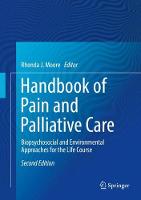Social and Interpersonal Dynamics in Pain
 -15%
portes grátis
-15%
portes grátis
Social and Interpersonal Dynamics in Pain
We Don't Suffer Alone
Prkachin, Kenneth M.; Vervoort, Tine; Karos, Kai; Trost, Zina
Springer International Publishing AG
07/2018
532
Dura
Inglês
9783319783390
15 a 20 dias
986
Descrição não disponível.
Preface.- Part I: Theoretical Foundations.- Chapter 1: Why Do We Care? Evolutionary Mechanisms in the Social Dimension of Pain.- Chapter 2: Toward the Social Communication Model of Pain.- Chapter 3: Developmental Dimensions in Understanding Interpersonal Features of Pain.- Chapter 4: An Affective-Motivational Account of Interpersonal Dynamics in Pain.- Part II: A Science of Pain Expression.- Chapter 5: Pain Behaviour: Unitary or Multidimensional Phenomenon?.- Chapter 6: When, How and Why Do We Express Pain?.- Chapter 7: Automatic, Objective, and Efficient Measurement of Pain Using Automated Face Analysis.- Part III: The Neuroscience of Interpersonal Pain Dynamics.- Chapter 8: The Neural Signature of Empathy for Physical Pain... Not Quite There Yet!.- Chapter 9: On the Overlap between Physical and Social Pain.- Chapter 10: Bridging the Gap between People and Animals: The Roots of Social Behavior and its Relationship to Pain.- Part IV: Effects of Facing Others in Pain.- Chapter 11: The Spectrum of Third-Person Pain: From Observation to Action.- Chapter 12: Facing Others in Pain: Why Context Matters.- Part V: Observer Responses to Others' Pain.- Chapter 13: Beyond Operant Theory of Observer Reinforcement of Pain Behavior.- Chapter 14: The Role of Non-Verbal Features of Caregiving Behaviour.- Chapter 15: Interpersonal Pain Dynamics in Couples: Interactions between Spouses' Physical Health Predict Caregiver Outcomes.- Chapter 16: Caregiving Impact Upon Sufferers' Cognitive Functioning.- Part VI: Across the Lifespan.- Chapter 17: Pain in Infancy: The Primacy of the Social Context.- Chapter 18: An Ecological and Lifespan Approach of Social Influences on Childhood Pain Experiences.- Chapter 19: Pain in Older Adults: Caregiver Challenges.- Part VII: Societal Context.- Chapter 20: Sex and Gender as Socio-Cultural Factors in Pain.- Chapter 21: Race and Pain: A Dual Injustice.- Part VIII: Towards Change: Targets and Methods for Intervention.- Chapter 22: Towards Change: Targeting Individual and Interpersonal Processes in Therapeutic Interventions for Chronic Pain.- Part IX: Conclusion.- Chapter 23: Where We've Been, Where We're At, Where Do We Go From Here?.
Este título pertence ao(s) assunto(s) indicados(s). Para ver outros títulos clique no assunto desejado.
Gate Control Theory of Pain;Clinical Experience of Pain Sufferers;Evolution of Pain;Affective-Motivational Models of Pain;Pain Expression;Neuroscience of Pain;Observer Response in Pain;Pain Communication;Pain Behavior;neuroscience of empathy;neonatal care and pain;sex differences in pain;comparative cognition and pain
Preface.- Part I: Theoretical Foundations.- Chapter 1: Why Do We Care? Evolutionary Mechanisms in the Social Dimension of Pain.- Chapter 2: Toward the Social Communication Model of Pain.- Chapter 3: Developmental Dimensions in Understanding Interpersonal Features of Pain.- Chapter 4: An Affective-Motivational Account of Interpersonal Dynamics in Pain.- Part II: A Science of Pain Expression.- Chapter 5: Pain Behaviour: Unitary or Multidimensional Phenomenon?.- Chapter 6: When, How and Why Do We Express Pain?.- Chapter 7: Automatic, Objective, and Efficient Measurement of Pain Using Automated Face Analysis.- Part III: The Neuroscience of Interpersonal Pain Dynamics.- Chapter 8: The Neural Signature of Empathy for Physical Pain... Not Quite There Yet!.- Chapter 9: On the Overlap between Physical and Social Pain.- Chapter 10: Bridging the Gap between People and Animals: The Roots of Social Behavior and its Relationship to Pain.- Part IV: Effects of Facing Others in Pain.- Chapter 11: The Spectrum of Third-Person Pain: From Observation to Action.- Chapter 12: Facing Others in Pain: Why Context Matters.- Part V: Observer Responses to Others' Pain.- Chapter 13: Beyond Operant Theory of Observer Reinforcement of Pain Behavior.- Chapter 14: The Role of Non-Verbal Features of Caregiving Behaviour.- Chapter 15: Interpersonal Pain Dynamics in Couples: Interactions between Spouses' Physical Health Predict Caregiver Outcomes.- Chapter 16: Caregiving Impact Upon Sufferers' Cognitive Functioning.- Part VI: Across the Lifespan.- Chapter 17: Pain in Infancy: The Primacy of the Social Context.- Chapter 18: An Ecological and Lifespan Approach of Social Influences on Childhood Pain Experiences.- Chapter 19: Pain in Older Adults: Caregiver Challenges.- Part VII: Societal Context.- Chapter 20: Sex and Gender as Socio-Cultural Factors in Pain.- Chapter 21: Race and Pain: A Dual Injustice.- Part VIII: Towards Change: Targets and Methods for Intervention.- Chapter 22: Towards Change: Targeting Individual and Interpersonal Processes in Therapeutic Interventions for Chronic Pain.- Part IX: Conclusion.- Chapter 23: Where We've Been, Where We're At, Where Do We Go From Here?.
Este título pertence ao(s) assunto(s) indicados(s). Para ver outros títulos clique no assunto desejado.
Gate Control Theory of Pain;Clinical Experience of Pain Sufferers;Evolution of Pain;Affective-Motivational Models of Pain;Pain Expression;Neuroscience of Pain;Observer Response in Pain;Pain Communication;Pain Behavior;neuroscience of empathy;neonatal care and pain;sex differences in pain;comparative cognition and pain












